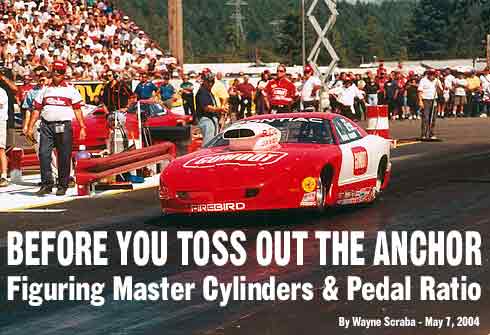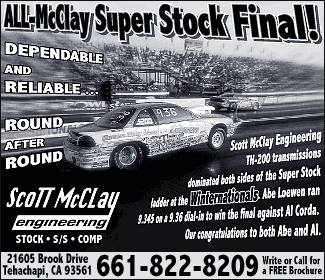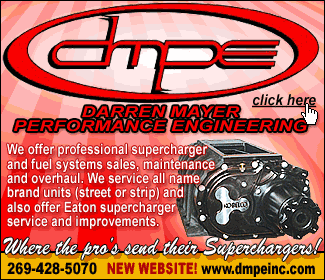
![]() ne
area racers tend to neglect is the brake master cylinder. After all, it doesnĮt
make the car one bit quicker or faster, and if the thing stops by the last turn-off
road, why worry? If you fall into that category, perhaps you should. Here's
why
ne
area racers tend to neglect is the brake master cylinder. After all, it doesnĮt
make the car one bit quicker or faster, and if the thing stops by the last turn-off
road, why worry? If you fall into that category, perhaps you should. Here's
why
There are countless (different) master cylinders available in today's marketplace, but for drag race door car applications, or any application with four-wheel brakes, be absolutely positive you use a dual or "tandem" assembly. Obviously, a dual master cylinder allows you to separate the brakes from front to rear. When shopping for a dual master cylinder, several features are critical, such as the piston bore dimensions and the location of the outlet ports. Believe it or not, many master cylinders (including those for countless late models with power brakes and ABS) have the outlet ports on the "wrong" (engine) side. This makes plumbing difficult (or impossible in some situations). Further to this, some master cylinders are not well suited to non-power boosted vehicles such as those seen in drag racing.
|
So which master cylinder is right for your application?
|
When it comes to "door car" drag race master cylinders,
this is one of the most common (and best) combinations.
|
These master cylinders are manufactured with an aluminum body along with a relatively large capacity plastic reservoir with dual outlet bores (which correctly face the driver side fender when mounted in the car). If there is a shortcoming to this master cylinder design, it's the size of the outlet fittings. The front fitting is a 9/16-20 Inverted Flare while the rear is a 1/2-20 Inverted Flare. Unfortunately, it's difficult to find appropriate adapter fittings for these flare dimensions. Lamb Components does offer a solution. They manufacture special #3 A-N male adapters specifically for these master cylinders (these Lamb fittings are relatively inexpensive and a real frustration-saver). FYI, the master cylinders sold by Mark Williams can have these Lamb fittings installed as an option.
| You'll also find that these master cylinders will require an adapter to fit the firewall on most vehicles. These adapters are designed to convert something such as a later model Firebird (which originally came equipped with a power booster) to the manual, Mopar pattern. Lamb Components offers several different adapters for varied applications and so does MPR (see the source box for more information). |
You'll also find that these master cylinders will require an adapter to fit the firewall on most vehicles. These adapters are designed to convert something such as a later model Firebird (which originally came equipped with a power booster) to the manual, Mopar pattern. Lamb Components offers several different adapters for varied applications and so does MPR (see the source box for more information).
Pedal Pushers
The pedal ratio is critical. What's pedal ratio? The brake pedal acts as a lever to increase the force you (the driver) apply to the master cylinder. In turn, the master cylinder forces fluid to the disc brake caliper pistons or drum brake wheel cylinders. If you examine a brake pedal, you'll see the pivot point (where the pedal swivels) and the mounting point for the master cylinder pushrod are usually different. By varying the length of the pedal, and/or the distance between the pushrod mount and the pivot, you can change how much force (from your leg) is required to energize the master cylinder. This is the "mechanical advantage" or pedal ratio. This formula will help you figure it out:
|
Input
Force X Pedal Ratio = PSI |
|
ADVERTISEMENT
 |
Translated, this is the amount of force exerted by your leg times the pedal ratio divided by the area of the brake piston(s). The typical adult male can exert approximately 300 pounds of force with one leg. If you've ever tried leg presses at a gym at 300 pounds, you'll know that's a bunch. Something in the order of 1/3 or 1/2 that figure is obviously more comfortable, even in a racecar. Of course, you also use the brakes to stage the car, and in some cases, racers "pump" the pedal in an attempt to increase holding power. But does this actually increase the brake line pressure? According to Mark Williams, this practice doesn't really change the pressure. If you have to pump the pedal to increase the holding power of the brakes, something has pushed the pistons back in the caliper (run out in the rotor, a cocked caliper, bad mounts are all examples). Another common cause is air in the system. Bottom line? If you have to pump the brakes to hold a car on the starting line, something is wrong. Pumping the pedal does not build pressure, although it might eliminate pedal travel.
| The average manual (non-power boosted) master cylinder will
require somewhere between 600 to 1,000 PSI to be totally effective. Somehow you have to translate the 100-150 pounds of leg force into 600-1,200 PSI. The way it's accomplished is by way of pedal ratio. While changing the overall length of the pedal is possible, it's usually easier (and far more practical) to shorten the distance between the pivot point and the master cylinder pushrod mount location. That's precisely how MPR modifies late model brake pedals in their power-to-manual brake conversions. |
| The typical Detroit pedal assembly looks like this. This vintage Nova hanging arrangement is designed to accept the brake pedal assembly, and if equipped with a clutch, that too. In contrast, most late model cars are designed with power brakes and that can spell trouble when it comes to pedal ratio. |
The average manual (non-power boosted) master cylinder will require somewhere between 600 to 1,000 PSI to be totally effective. Somehow you have to translate the 100-150 pounds of leg force into 600-1,200 PSI. The way it's accomplished is by way of pedal ratio. While changing the overall length of the pedal is possible, it's usually easier (and far more practical) to shorten the distance between the pivot point and the master cylinder pushrod mount location. That's precisely how MPR modifies late model brake pedals in their power-to-manual brake conversions.
So far, so good. Brake line pressure is a different thing than the force you apply to the pedal. Force acts in one direction and is addressed in pounds. Pressure acts in all directions against surrounding surfaces and is addressed in pounds per square inch or PSI. "Levers" (brake pedals as outlined above) can be used to change the force. Inside the hydraulic system the surface area of the piston is what is affected by pressure. Decreasing the bore size of the master cylinder will increase the pressure it can build. Pistons in master cylinders are specified by bore size. But there's a catch: The area of a circle (or bore) is piār-squared. The area of the piston surface increases or decreases with the square of the bore size or diameter. The area of a 1-1/8-inch master cylinder is approximately 0.994-inch. The area of a 1.00-inch bore master cylinder is approximately 0.785-inch. As a result, switching from the larger master cylinder to the smaller version will increase the line pressure approximately 26.5 percent, assuming that pedal ratio hasn't changed.
|
ADVERTISEMENT
 |
According to Mark Williams, the normal bore size in a drag racecar where rear two or four piston (1-3/4") brakes are used on something like a dragster (no front brakes), is a single 7/8-inch master cylinder assembly. If a single piston front design brake is used in conjunction with a pair of four piston rear calipers, a 1.00-inch tandem master cylinder will work. In applications where four piston brakes are used front and rear, a 1-1/8-inch bore tandem master cylinder will work. Mark points out an important factor with regard to master cylinders. "Attachment to frame rails or the roll bar is preferred to ensure a solid mount. Often times, a spongyĮ brake can be attributed to master cylinder deflection. Do not use the firewall sheet metal as the sole mount". This is an interesting point, especially in light of old racing articles regarding the structural integrity of firewalls (the "oil can syndrome"). Many experienced racers and chassis builders have found the cause of cracking in the area of the master cylinder had absolutely nothing to do with the structural integrity of the roll cage or the chassis. Instead, it is the force of the driver's leg against the brake pedal that creates the cracking. Good examples of this include many vintage cars with manual (non-boosted) brakes that have never been modified. The sheet metal surrounding the master cylinder eventually fatigues in these cars, even though they were never modified (meanwhile, similar un-modified cars with power brakes seldom have evidence of firewall fatigue). That's why sharp door car chassis builders routinely brace the master cylinder to the roll cage (or the forward engine compartment hoop).
 If you take close look at this pedal, you can see two different master cylinder pushrod mount holes ā one is for a booster-equipped application, while the other is for a non-boosted brake arrangement. For a late model, non-boosted manual application, companies such as MPR modify the pedal assembly by creating a mount that is higher (up the pedal) than the original. By moving the mount position higher, the pedal ratio is improved. |
It's easy to see that as you increase the pedal force or the pedal ratio (or both), the stroke of the master cylinder is shortened (brake line pressure is unaffected). When you increase the size of the master cylinder piston, you decrease the output pressure of the master cylinder. A smaller master cylinder piston will exert more line pressure with the same amount of force (pedal ratio) than a master cylinder piston with a larger piston area. Unfortunately, there's another catch: Since the brake line fluid pressure is working against the surface of the wheel cylinder (or disc brake piston), increasing the area of the cylinder will increase brake torque. That's why foot brake racers will often replace wheel cylinders with larger models. A good example is an early GM wheel cylinder. Typically they'll measure 3/4-inch. These can be replaced with either 7/8-inch or 15/16-inch cylinders (some domestic station wagons had huge drum brake wheel cylinders). By increasing the size of the wheel cylinder, the "clamping" power of the drum brakes will also increase, which in turn makes it easier to hold the car on the starting lineagainst the torque converter. The bottom line is to find a wheel cylinder that works for your application. Playing with wheel cylinders (bore sizes) also has an effect upon brake pedal "feel". Just remember this when mixing and matching OEM parts.
What this all means is if you need to improve the stopping power of your car, or if you need to reduce the effort it takes to depress the pedal, then you have several options: (A) Decrease the master cylinder bore size; (B) Increase the pedal ratio; (C) Increase the wheel cylinder bore size. If you increase the pedal ratio, you'll have more travel at the master cylinder piston. If you decrease the master cylinder bore size, the piston has to travel further to move the same amount of fluid. Typically, a master cylinder has approximately 1-1/2-inch to 1-3/4-inch of stroke (travel). The idea here is coordinate the pedal ratio with the bore size to arrive at approximately half of the stroke (roughly 1-inch) in order to make the brakes feel comfortable, and of course, to bring the car to a halt.
| Sources | |
| Mark Williams Enterprises 765 South Pierce Avenue Louisville Colorado 80027 PH# 303-665-6901 |
MPR Race Cars 5851 Scotch Settlement Road Almont, Michigan 48003 PH# 810-798-8998 |
Copyright 1999-2004, Drag Racing Online and Racing Net Source